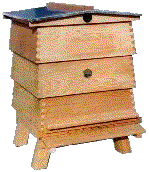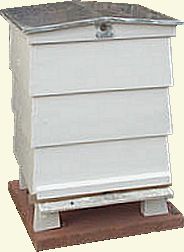

William Broughton Carr (note the initials) published details of this hive in 1890, although the original design was very different from those of today that are characterised by the often white painted, taper-sided (telescopic) lifts, which were introduced by James Lee in 1899. It is this one that most people in the U.K. will recognise as a beehive.
The WBC is the only double walled hive now in general use. It has changed designs over the years and before the introduction of the telescopic design we now recognise, the lifts (outside casings) were straight sided with plinths around the bottom that overlapped the top of the lift below to allow water to run off. The reason for the lifts is to cover the inner boxes that are made of much thinner timber and to increase insulation. In my early beekeeping years I had a wide variety of WBCs, which, with different shapes and sizes were difficult to operate.
Before standardisation in 1946 (B.S.1300) revised 1960, virtually all manufacturers had their own sizes that created a lot of problems, especially if buying hives secondhand. C.T. Overton of Crawley Sussex, made their hives oblong with a flat roof that sloped from front to back, others were square, though often of slightly different dimensions. Many roofs were gabled, with a variety of covering including metal, felt and canvas that was painted. This is no longer the case and hives from all major manufacturers should be compatible.
It is often felt that the double walled concept was warmer for the bees in winter than single walled hives, but in my area of West Sussex I have not seen any noticeable difference. I suspect colonies in WBCs may take a little longer to get going in the spring, due to the greater insulation. I'm sure there is an advantage in more exposed areas.
The maintenance needs to be good, otherwise damp will get in the cavity through loose fitting corners during the winter and be bad for the bees.
As with other things in beekeeping, often through lack of knowledge and experience, WBCs are often discredited, unfairly in my view, but in well over 50 years of beekeeping I have been involved in using many of them. I think they are as good as any hive for the ordinary beekeeper who wants to keep a couple of hives at home. The problem comes when you have a lot of hives, because you have much more equipment to store and maintain and colony inspections take longer. I haven't used WBCs myself for a long time, but I regularly handle bees belonging to other beekeepers and demonstrate when invited to at other BKAs meetings. If they are well looked after the bees won't mind what they are in.
They are expensive compared to Nationals, but the small-scale beekeeper who wants to enjoy their beekeeping may not be concerned about cost.
The frames used are B.S. and in the past, many beekeepers ran both WBC and Nationals as the frames are interchangeable. The WBC brood box takes 10 frames and is said by some to be too small for what they call the "modern" bee, but with non-prolific queens I have found you can keep bees in them throughout the year without the threat of starvation. On many occasions I have taken large crops of honey from them.
Beware of secondhand WBCs, as there are often bodged repairs and home made brood boxes and supers - very often these aren't the correct size and badly made.
There are dimensional and construction details here for the telescopic WBC hive. This information is by kind permission of the Scottish Beekeepers Ass'n.
Originally written by Dave Cushman. Rewritten by Roger Patterson.
Page created pre-2011
Page updated 03/12/2022